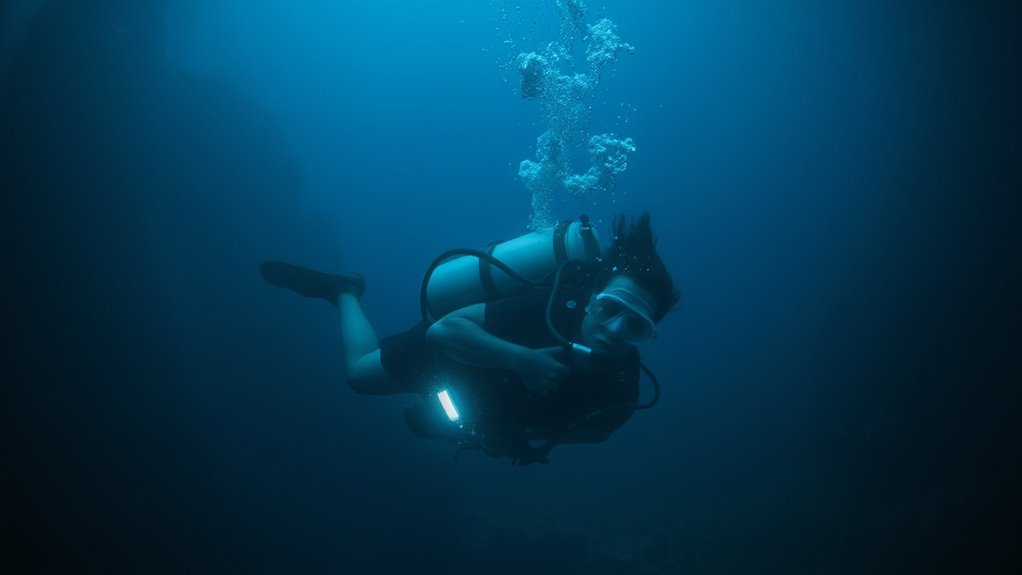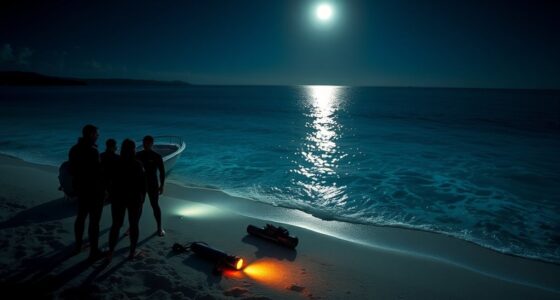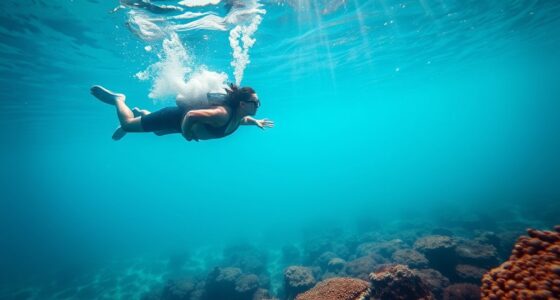Understanding nitrogen narcosis and decompression sickness is essential for your safety while diving. Nitrogen narcosis occurs from breathing nitrogen under high pressure and can cause disorientation and impaired judgment. Decompression sickness happens when you ascend too quickly, leading to painful nitrogen bubbles in your body. To avoid these risks, plan your dives cautiously, monitor your depth, and ascend slowly with safety stops. By keeping these factors in mind, you can enhance your diving experience and stay safe during your adventures.
Key Takeaways
- Nitrogen narcosis occurs under high pressure, causing symptoms like disorientation and impaired judgment, which can lead to risky decisions.
- Decompression sickness arises from ascending too quickly, resulting in nitrogen bubbles forming in tissues, causing joint pain and dizziness.
- Prevent nitrogen narcosis by recognizing early signs and ascending to shallower depths when symptoms occur.
- Slow ascents and safety stops are essential to prevent decompression sickness, allowing nitrogen to safely off-gas from the body.
- Effective dive planning and monitoring help minimize risks associated with nitrogen narcosis and decompression sickness during dives.

When you’re diving profound underwater, you might not realize that the very air you breathe can turn into a double-edged sword. The essence of your dive, oxygen, and nitrogen, can lead you to exhilarating experiences, but they also pose serious risks like nitrogen narcosis and decompression sickness. Understanding these conditions is essential for every diver, as awareness of their effects can markedly enhance your safety.
Nitrogen narcosis, often referred to as “the bends,” is a state of intoxication caused by breathing nitrogen under high pressure. As you descend, the increased pressure causes nitrogen to dissolve into your bloodstream, affecting your brain and leading to disorientation, impaired judgment, and even euphoria. You might feel giddy or overly confident, but these effects can cloud your decision-making abilities. That’s why awareness of these effects is crucial. If you recognize the signs early, you can take action to ascend to a shallower depth and alleviate these symptoms.
Decompression sickness, on the other hand, occurs when you ascend too quickly after a deep dive. The rapid decrease in pressure causes nitrogen bubbles to form in your tissues and bloodstream, which can lead to joint pain, dizziness, or severe neurological issues. To prevent this, you must implement effective prevention strategies. Slow ascents and safety stops are indispensable. Following the recommended ascent rates allows your body to off-gas nitrogen gradually, reducing the risk of developing symptoms.
Proper dive planning can’t be overstated. Before you hit the water, establish a dive profile that considers depth and duration, and always stick to it. Monitor your time at depth and keep an eye on your gauge, ensuring you’re aware of how deep you are and for how long. Also, make it a habit to dive with a buddy who can help you recognize any signs of narcosis or decompression sickness.
Finally, post-dive, take a moment to reflect on your experience. It’s easy to overlook the importance of surface intervals, but giving your body time to off-gas nitrogen is essential. By incorporating these prevention strategies and staying aware of the effects of nitrogen narcosis and decompression sickness, you can dive confidently and safely, ensuring that your underwater adventures remain enjoyable and free from complications. Additionally, understanding contrast ratios can help you appreciate the visual aspects of underwater photography, enhancing your overall diving experience.
Frequently Asked Questions
Can Nitrogen Narcosis Affect Divers at Shallow Depths?
Yes, nitrogen narcosis can affect divers at shallow depths, although it’s more common at greater depths. Even at shallow depth, you might experience narcosis effects if you’re diving in certain conditions, like high pressure or with increased nitrogen levels. It’s crucial to stay aware of your mental clarity and reactions while diving, as even mild narcosis can impair your judgment. Always dive with caution, regardless of how deep you are.
What Are the Symptoms of Mild Decompression Sickness?
Mild decompression sickness can feel like a storm brewing in your body, subtly warning you of trouble. Symptoms overview includes joint pain, fatigue, and a mild rash. You might also experience dizziness or a slight headache, as if your mind’s caught in a fog. In mild cases, these symptoms can often resolve quickly with proper rest and hydration, but don’t ignore them—your body’s trying to tell you something important!
How Can I Prevent Nitrogen Narcosis While Diving?
To prevent nitrogen narcosis while diving, you should always wear appropriate safety gear and plan your dives carefully. Stick to shallower depths, especially if you’re inexperienced, and avoid rapid descents. Monitor your air supply and stay within your limits. Consider using a dive computer to track your depth and time. Staying well-hydrated and avoiding alcohol before diving can also help. Proper preparation and awareness make a significant difference in your safety underwater.
Is There a Safe Depth Limit to Avoid Decompression Sickness?
Yes, a safe depth limit to avoid decompression sickness is generally around 30 meters (100 feet) for recreational divers. Staying within this range helps you stay below nitrogen limits, minimizing your risk. However, it’s essential to make gradual ascents and adhere to dive tables or computers. If you dive deeper, consider using a safety stop at 5 meters (15 feet) for three minutes to further reduce your chances of experiencing issues. Dive smart and stay safe!
Can Medications Help Treat Nitrogen Narcosis or Decompression Sickness?
Medications aren’t typically used to treat nitrogen narcosis, but they might help with symptoms related to decompression sickness. While some medications can reduce pain or inflammation, their effectiveness varies. You should consider alternative treatments like hyperbaric oxygen therapy, which can markedly aid in recovery. Always consult a healthcare professional for tailored advice, as they can provide the best options based on your situation and ensure you’re getting the right care.
Conclusion
In summary, understanding nitrogen narcosis and decompression sickness is essential for any diver. By recognizing the symptoms and adhering to safety protocols, you can minimize risks and enjoy your underwater adventures. For example, a diver named Sarah experienced narcosis at 100 feet, feeling euphoric and disoriented. She ignored her dive plan, which led to a dangerous ascent and subsequent decompression sickness. Learning from her experience, you can prioritize safety and dive responsibly to avoid similar pitfalls.










